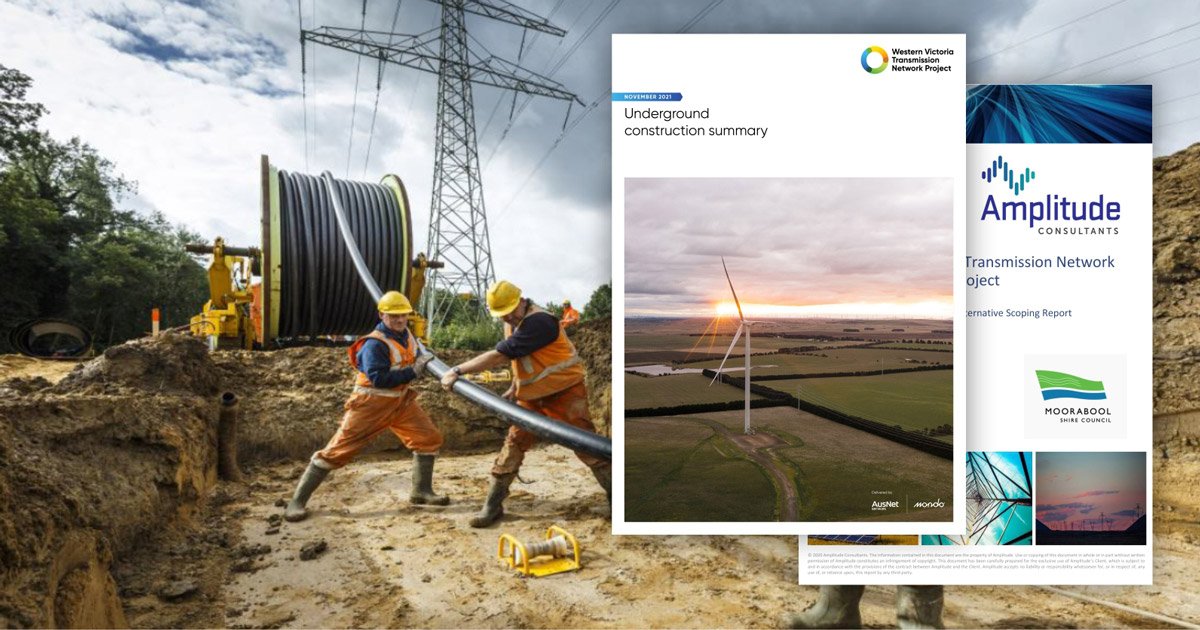Review of AusNet Services WVTNP Underground Construction Summary Report

AusNet’s preliminary findings require further scrutiny.
On 26 November 2021, AusNet announced the final preferred transmission path for the Western Victoria Transmission Network Project (WVTNP). A proposed 190-kilometre high voltage transmission line between Sydenham and Bulgana in Western Victoria.
AusNet also released the preliminary findings of its investigation into undergrounding the transmission line as required by the Environmental Effect Statement (EES) process.
While AusNet's findings are preliminary and are still subject to peer review, their investigation finds that undergrounding the HVAC transmission line along their proposed routes would cost approximately 16 times more. As a result AusNet have dismissed undergrounding and have recommend overhead construction.
Earlier this year, June 2021, the Moorabool Shire Council released a High-Level HVDC Alternative Scoping Report for the WVTNP. This report was independently prepared by Amplitude Consultants, an Australian-based engineering consulting company that provides specialist consulting services to clients involved in the transmission and distribution of electricity. The Amplitude report has been referenced in AusNet's underground construction summary.
Dismissal of an underground HVDC solution and announcement of a final preferred transmission path at this stage of the EES process has prompted a review of AusNet's Underground construction summary.
As a side-by-side comparison, AusNet's Underground construction summary is what it claims to be. A broad overview of HVAC, HVDC, underground construction, potential routes and key differences in environmental impacts.
However the absence of design and cost detail for both the underground HVAC and HVDC options referenced make it difficult to verify and substantiate the conclusion.
When compared to the Amplitude High-Level HVDC Alternative Scoping Report it becomes evident there is conflicting information that needs to be clarified by an independent HVDC expert.
Purpose of this review
The purpose of this paper is to provide a high-level comparative review of the undergrounding concepts and relative design information to understand how AusNet Services (AusNet) has estimated the underground costs of HVAC to be 16 times greater than overhead transmission and subsequently dismissed underground alternatives.
Key finding of this review
- AusNet’s summary indicates these are 'preliminary findings' that have not been peer reviewed.
- Technical specialists who compiled the information are not identified or credentialled, nor is any information referenced to allow independent verification.
- AusNet's summary does not provide costs for its overhead HVAC, underground HVAC or underground HVDC solutions.
- AusNet estimates underground HVAC is likely to cost 16 times more than an overhead HVAC solution. However, AusNet's estimate is not supported by a detailed cost breakdown.
- Amplitude's report estimates the cost of underground HVDC to range between 3.15 and 5.7 times the cost of an overhead HVAC solution.
- AusNet's HVDC concept design appears to have overestimated the sets of parallel cables, number of trenches and width of easements required for underground HVDC transmission. This requires further scrutiny as AusNet’s assessment results in a notable increase in the number of cables and trenches and easement width required which impacts route selection, ease of construction and the environment.
- AusNet estimate 24.5m total trench width
- Amplitude estimate 2-3m total trench width
- AusNet have said the environmental impact is greater for underground HVDC. This is based on assumptions around the number of cables required, sets of parallel cables, trench and easement widths.
Recommendations
- AusNet’s preliminary findings require further scrutiny.
- Misconceptions may have inadvertently led to overhead HVAC construction being recommended as the preferred solution by the investigation and underground solutions prematurely dismissed.
- To satisfy the requirements of the EES, Energy Grid Alliance recommends that proportionate and robust investigations be conducted on feasible technologies and alternate corridors by a suitably qualified independent expert before the final transmission corridor, path and technology can be determined.
The EES process seeks the project option that delivers superior environmental outcomes. This process does not seek the cheapest option. Underground HVDC is proven to deliver these outcomes.

